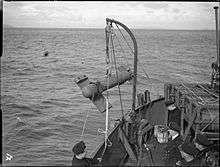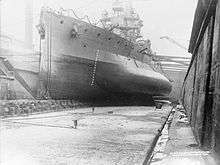Paravane (weapon)
.jpg)



The paravane, a form of towed underwater "glider", was developed from 1914–16 by Commander Usborne and Lieutenant C. Dennistoun Burney, funded by Sir George White, founder of the Bristol Aeroplane Company.[1]
Usage
Initially developed to destroy naval mines, the paravane would be strung out and streamed alongside the towing ship, normally from the bow. The wings of the paravane would tend to force the body away from the towing ship, placing a lateral tension on the towing wire. If the tow cable snagged the cable anchoring a mine then the anchoring cable would be cut, allowing the mine to float to the surface where it could be destroyed by gunfire. If the anchor cable would not part, the mine and the paravane would be brought together and the mine would explode harmlessly against the paravane. The cable could then be retrieved and a replacement paravane fitted.
.jpg)
Lieutenant Burney developed explosive paravanes as an anti-submarine weapon, a "high speed sweep". It was a paravane, containing 80 pounds (36 kg) of TNT towed by an armoured electric cable. The warhead was fired automatically as soon as the submarine touched the paravane or towing cable or by hand from the ship's bridge. It could be quickly deployed into the water, could be towed up to 25 knots (46 km/h) and recovery if unsuccessful was reasonably simple.
See also
Notes
- ↑ Leasor, James (2001) [1957]. The Millionth Chance: The Story of the R.101. Kelly Bray: Stratus Books. p. 66.
References
-
 Chisholm, Hugh, ed. (1922). "Paravane". Encyclopædia Britannica (12th ed.). London & New York.
Chisholm, Hugh, ed. (1922). "Paravane". Encyclopædia Britannica (12th ed.). London & New York.
External links
| Wikimedia Commons has media related to Paravane (weapon). |